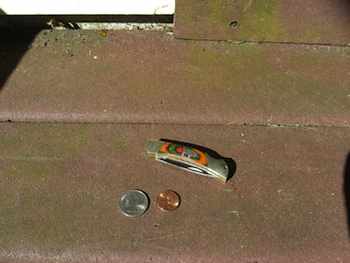By Tim Carter

These dark spots on the composite decking are probably mildew or some other mold growth. Oxygen bleach almost always will restore the original look
DEAR TIM:
We put down Trex decking in 2008. The composite lumber has developed dark spots all over it. It started with a few spots and has multiplied over the two-year period. What is causing the spotting, and how can it be removed? Is there anything that can be done to prevent the ugly spots? We purchased this material thinking it would be maintenance-free and are very unhappy. --Trish A., Bristol, Conn.
DEAR TRISH:
You're not the first consumer to write to me about this issue with composite decking, and I'm sure you won't be the last. I have personal experience with this decking material, as it's on two very large decks and my front porch at my New Hampshire home. My own composite decking has spotting issues, algae growth and uneven coloration issues.
I've worked with decks of all types for over 36 years, and I've seen the issues you're having can happen on just about every decking material. In other words, it's highly unlikely that the decking material itself is causing the entire problem. However, your deck and mine might be more prone to issues for a number of reasons.
The dark spots on your deck, based on the photo you sent me, appear to be mold and mildew. This spotting can happen on any deck. Mold and mildew feed on natural materials such as wood fiber, natural sugars, dirt, dust, grease, oils and food. If you have trees or other vegetation near your deck shading the decking, these might be manufacturing airborne sugars that coat the deck. The sugars can float through the air from trees near the deck.
Some trees produce more of this than others. Perhaps you've seen sap coating a freshly cleaned car that's parked under a tree. The spots show up easily on the high-gloss surface of a car paint job, but are tough to detect on a flat finish such as your deck boards.
The mold and mildew can also feed directly off of the wood fibers in your Trex decking. The FAQ page at the Trex web site states, "While most of the raw materials used in making Trex are recycled, these materials are carefully processed to ensure the highest level of quality and performance." However, it's possible that mold and mildew spores could be already present in the raw recycled wood material that's used to make the decking.
Add to this the possibility that the wood fibers in the decking may not have any preservative added to them at the factory. If this is the case, then the wood fibers, or concentrated areas of them in the decking could easily support the growth of mold and mildew. I see it happening on my own Trex deck.
A visit to the Trex website reveals they have a comprehensive cleaning guide that may help you. They are quick to point out that a powerful pressure washer, one that delivers a pressure stream greater that 1,500 pounds per square inch (psi), is to be avoided. What's more, never hold the pressure wand closer than 12 inches from the decking surface. A concentrated stream of high-pressure water can erode the wood fibers in the decking.
No deck is maintenance free, not even the expensive composite decks. All will have to be periodically cleaned from time to time. I have had the best luck cleaning my Trex deck with oxygen bleach. This is a powder that you mix with water. It works to clean any decking material. The oxygen ions in the solution readily clean mold, mildew, algae and any food you may have spilled on the deck. What I like about oxygen bleach is that it removes the gray coloration from the small wood fibers in my decking, making it look like new. The sun's UV rays cause the wood fibers in the decking to turn gray.
I apply the oxygen-bleach solution and allow it to sit for 15 minutes, never allowing it to evaporate. It's best to work early or late in the day when the decking is in the shade. After the wait period, use a stiff scrub brush to clean the decking. Rinse with clear water from a garden hose. You'll be amazed at how clean and new the decking will look.
Some spotting you see may not be mold or mildew. I see that on my own Trex decking. I've studied this very closely with a magnifying glass and believe it to be a manufacturing characteristic. It appears that the dark spots are areas where there is a higher concentration of the recycled colored plastic.
If this is the case, it make sense that over time you'll see uneven coloration as the thin film of plastic wears off those areas nearby that have more wood fibers than plastic.
I've visited a manufacturing plant where composite decking is made and have seen how the wood fibers and plastic are kept separate until just before they enter the extruding machine. Although the manufacture makes every effort to mix the ingredients evenly, I can see how it's possible that this doesn't always happen.
Available at Amazon.com:
Cut Your Energy Bills Now: 150 Smart Ways to Save Money & Make Your Home More Comfortable & Green
It's Easy Being Green: A Handbook for Earth-Friendly Living
Copyright © Tim Carter, Ask The Builder. All rights reserved.
AUTOS | HOBBIES | EDUCATION | FAMILY | FASHION | FOOD & RECIPES | HOME DECOR | RELATIONSHIPS | PARENTING | PETS | TRAVEL | WOMEN
Home & Garden - Blotches on Composite Decking Easily Tackled with Oxygen Bleach